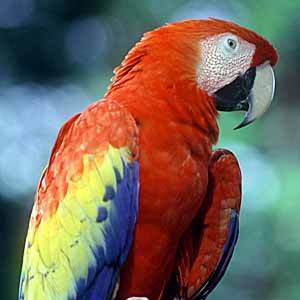Macaw - Scarlet
Red and Yellow Macaw Scientific Name: Ara macao
Fri, 1st November, 2024 - 4:33 am GMT
Sponsor Ads:

Alternative Name
Red and Yellow Macaw Scientific Name: Ara macaoBasic Info
The Scarlet Macaw grows to about 33.5 inches. Sometimes called the Red and Yellow Macaw, the base plumage color is a brilliant red. The tops of the wings are yellow, as are the irises and sometimes the edges of the feathers on the back of the head. Scarlet Macaws have green tips on the feathers of their wing coverts. The tail coverts are pale blue, and the wing feathers have blue outer webs. The upperside of the tail is mostly red feathers with blue edges. Scarlet Macaws may have light traces of red feather lines on their bald whitish face patches. The bill has blackish edges and is horn colored, and the lower mandible is dark gray or blackish. Scarlet Macaws have dark gray feet.
Health
Scarlet Macaws need plenty of wood to chew on. They need very large metal and mesh enclosures: outside, a 24 by nine by six foot space with an nine by six by six foot enclosed shelter from the elements will work nicely. Provide a nesting box as well, and be sure the opening is large enough for your Scarlet Macaw to squeeze through! Scarlet Macaws love to interact with other birds, but may get aggressive toward like-size birds in the mating season and have even been known to show aggression toward their keepers at this time. Breeding In the wild, Scarlet Macaws eat insects during the breeding season, which occurs in the spring in Central America and in the winter in South America. The reproduction rate is low due to disease, predation, and flooding which destroy eggs and young Scarlet Macaws, and pairs do not breed every year. They use the same nest in a dead tree or live tree year after year. The young remain close to the parents for sometime after leaving the nest. Breeding season usually begins in April in captivity and pairs may be isolated or left in a large aviary. Be careful, because Scarlet Macaws may become aggressive at this time! The clutch consists of one to three eggs that incubate for about three weeks. Infertile eggs are frequently laid. The hatchlings will be in the fledgling phase for about 90 days while they remain with their parents. During this time, only inspect the nesting box while the parent Scarlet Macaws are not present, or they will become quite upset and may injure their eggs. Scarlet Macaws in colder climates will only achieve fertility if kept indoors. Immature Scarlet Macaws have light lower mandibles and brown eyes.Habitat
Inhabits Pacific coast scrubland and lowland cultivated areas with scattered forests.Behavior
The Scarlet Macaw is a beautiful bird with a sweet, inquisitive nature and friendly, outgoing personality! In the wild, Scarlet Macaws live in family groups of up to thirty birds, but pair off within the groups. Occasionally, isolated pairs of Scarlet Macaws are observed. They are highly social and are often seen keeping the company of Green-Winged or Blue and Yellow Macaws. While flying, Scarlet Macaws give regular, raucous croaking calls. When perched, Scarlet Macaws are nearly silent, and are generally extremely cautious when near the ground or in areas where raptors might prey upon them. They regularly visit clay banks where they consume mineral clay in order to obtain the nutrients they need to neutralize the toxins released into their systems from eating unripe fruit.In warm weather, spray your Scarlet Macaw, as they love to bathe, and be sure to have fresh water readily available. Scarlet Macaws should be kept warm with a bit of humidity, as this is their natural clime. They are talkative and social, and may be kept with other birds except for during their breeding season. They love human attention and are curious, affectionate, and docile, forming close bonds with their handlers.Origin
Central and South AmericaHistory
Native to tropical forests below 3300 feet, the Scarlet Macaw also inhabits Pacific coast scrubland and lowland cultivated areas with scattered forests. Found in parts of Panama, Southeast Mexico, Northern Bolivia and Brazil, Northern and Eastern Columbia, Eastern Peru and Ecuador, Surinam, the Guyanas, and Southern Venezuela, the Red and Yellow Macaw is not as common as the Blue and Yellow Macaw due to habitat loss, hunting for food, and trapping for the pet trade.Common Foods
Scarlet Macaws feed upon both unripe and ripe fruits, in addition to seeds and nuts, greenery, flowers and berries. In captivity, you should feed your Scarlet Macaws greens, a wide variety of fruits and vegetables, nuts and seed mixes and a mineral supplSponsor Ads:
"How victory may be produced for them out of the enemy's own tactics--that is what the multitude cannot comprehend." -- Sun Tzu, The Art of War
Macaw - Scarlet
Coded by: BGID® | ALL RIGHTS RESERVED Copyright © 2000-2024
Disclaimer | Privacy | Report Errors / Contact | Credits








 versus
versus  The role of its Army, Politics, and Status in the World.
The role of its Army, Politics, and Status in the World. 
 versus
versus 
 This Thread is about the North Korean Military itself - the kind of army, navy, and air force they have.
This Thread is about the North Korean Military itself - the kind of army, navy, and air force they have. 
 versus
versus  versus
versus 
 versus
versus  versus
versus